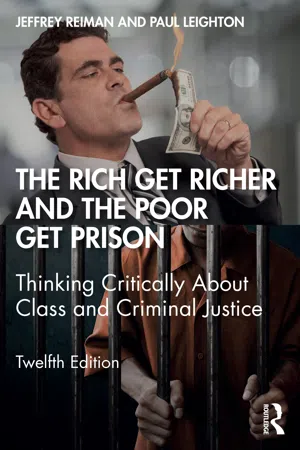
The Rich Get Richer and the Poor Get Prison
Thinking Critically About Class and Criminal Justice
- 260 pages
- English
- ePUB (mobile friendly)
- Available on iOS & Android
The Rich Get Richer and the Poor Get Prison
Thinking Critically About Class and Criminal Justice
About this book
For 40 years, this classic text has taken the issue of economic inequality seriously and asked: Why are our prisons filled with the poor? Why aren't the tools of the criminal justice system being used to protect Americans from predatory business practices and to punish well-off people who cause widespread harm?
This new edition continues to engage readers in important exercises of critical thinking: Why has the U.S. relied so heavily on tough crime policies despite evidence of their limited effectiveness, and how much of the decline in crime rates can be attributed to them? Why does the U.S. have such a high crime rate compared to other developed nations, and what could we do about it? Are the morally blameworthy harms of the rich and poor equally translated into criminal laws that protect the public from harms on the streets and harms from the suites? How much class bias is present in the criminal justice system – both when the rich and poor engage in the same act, and when the rich use their leadership of corporations to perpetrate mass victimization?
The Rich Get Richer shows readers that much of what goes on in the criminal justice system violates citizens' sense of basic fairness. It presents extensive evidence from mainstream data that the criminal justice system does not function in the way it says it does nor in the way that readers believe it should. The authors develop a theoretical perspective from which readers might understand these failures and evaluate them morally—and they to do it in a short text written in plain language.
Readers who are not convinced about the larger theoretical perspective will still have engaged in extensive critical thinking to identify their own taken-for-granted assumptions about crime and criminal justice, as well as uncover the effects of power on social practices. This engagement helps readers develop their own worldview.
New to this edition:
- Presents recent data comparing the harms due to criminal activity with the harms of dangerous—but not criminal—corporate actions
- Updates statistics on crime, victimization, incarceration, wealth, and discrimination
- Increased material for thinking critically about criminal justice and criminology
- Increased discussion of the criminality of middle- and upper-class youth
- Increased coverage of role of criminal justice fines and fees in generating revenue for government, and how algorithms reproduce class bias while seeming objective
- Streamlined and condensed prose for greater clarity
Frequently asked questions
- Essential is ideal for learners and professionals who enjoy exploring a wide range of subjects. Access the Essential Library with 800,000+ trusted titles and best-sellers across business, personal growth, and the humanities. Includes unlimited reading time and Standard Read Aloud voice.
- Complete: Perfect for advanced learners and researchers needing full, unrestricted access. Unlock 1.4M+ books across hundreds of subjects, including academic and specialized titles. The Complete Plan also includes advanced features like Premium Read Aloud and Research Assistant.
Please note we cannot support devices running on iOS 13 and Android 7 or earlier. Learn more about using the app.
Information
CHAPTER 1
Crime Control in America
Nothing Succeeds Like Failure
Is it crime and punishment that go hand in hand? Or does punishment feed the crime that plagues our land?
Failure is in the eye of the beholder.
The Failure of Tough on Crime
There is something mighty wrong when a candidate for the highest office bemoans violence in the streets but votes against the war on poverty, votes against the Civil Rights Act, and votes against major educational bills that come before him.5
Table of contents
- Cover
- Half Title
- Title Page
- Copyright Page
- Dedication
- Brief Contents
- Table of Contents
- Figure and Tables
- Preface to the Twelfth Edition
- Acknowledgments for the First Edition
- Introduction: Criminal Justice Through the Looking Glass, or Winning by Losing
- Chapter 1 Crime Control in America: Nothing Succeeds Like Failure
- Chapter 2 A Crime by Any Other Name...
- Chapter 3 … And the Poor Get Prison
- Chapter 4 To the Vanquished Belong the Spoils: Who Is Winning the Losing War Against Crime?
- Conclusion: Criminal Justice or Criminal Justice
- Appendix I The Marxian Critique of Criminal Justice
- Appendix II Between Philosophy and Criminology
- Index